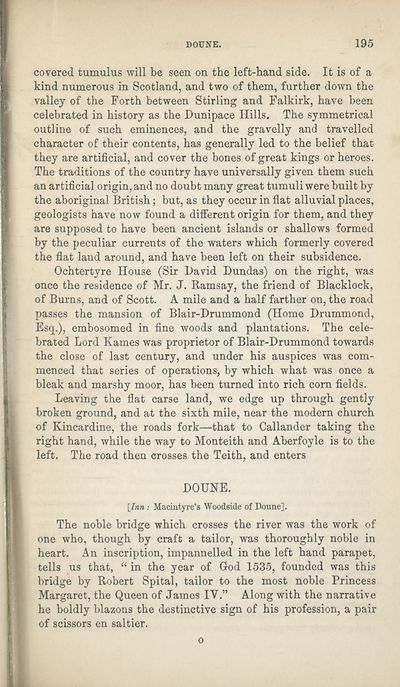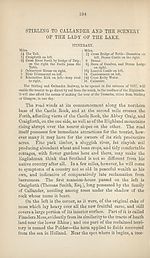Download files
Complete book:
Individual page:
Thumbnail gallery: Grid view | List view

DOUNE.
195
covered tumulus will be seen on the left-hand side. It is of a
kind numerous in Scotland, and two of them, further down the
valley of the Forth between Stirling and Falkirk, have been
celebrated in history as the Dunipace Hills. The symmetrical
outline of such eminences, and the gravelly and travelled
character of their contents, has generally led to the belief that
they are artificial, and cover the bones of great kings or heroes.
The traditions of the country have universally given them such
an artificial origin, and no doubt many great tumuli were built by
the aboriginal British; but, as they occur in fiat alluvial places,
geologists have now found a diflerent origin for them, and they
are supposed to have been ancient islands or shallows formed
by the peculiar currents of the waters which formerly covered
the flat land around, and have been left on their subsidence.
Ochtertyre House (Sir David Dundas) on the right, was
once the residence of Mr. J. Ramsay, the friend of Blacklock,
of Burns, and of Scott. A mile and a half farther on, the road
passes the mansion of Blair-Drummond (Home Drummond,
Esq.), embosomed in fine woods and plantations. The cele¬
brated Lord Karnes was proprietor of Blair-Drummond towards
the close of last century, and under his auspices was com¬
menced that series of operations, by which what was once a
bleak and marshy moor, has been turned into rich com fields.
Leaving the flat carse land, we edge up through gently
broken ground, and at the sixth mile, near the modern church
of Kincardine, the roads fork—that to Callander taking the
right hand, while the way to Monteith and Aberfoyle is to the
left. The road then crosses the Teith, and enters
DOUNE.
[Inn: MacIntyre’s Woodside of Donne].
The noble bridge which crosses the river was the work of
one who, though by craft a tailor, was thoroughly noble in
heart. An inscription, impannelled in the left hand parapet,
tells us that, “ in the year of God 1535, founded was this
bridge by Robert Spital, tailor to the most noble Princess
Margaret, the Queen of James IV.” Along with the narrative
he boldly blazons the destinctive sign of his profession, a pair
of scissors en saltier.
195
covered tumulus will be seen on the left-hand side. It is of a
kind numerous in Scotland, and two of them, further down the
valley of the Forth between Stirling and Falkirk, have been
celebrated in history as the Dunipace Hills. The symmetrical
outline of such eminences, and the gravelly and travelled
character of their contents, has generally led to the belief that
they are artificial, and cover the bones of great kings or heroes.
The traditions of the country have universally given them such
an artificial origin, and no doubt many great tumuli were built by
the aboriginal British; but, as they occur in fiat alluvial places,
geologists have now found a diflerent origin for them, and they
are supposed to have been ancient islands or shallows formed
by the peculiar currents of the waters which formerly covered
the flat land around, and have been left on their subsidence.
Ochtertyre House (Sir David Dundas) on the right, was
once the residence of Mr. J. Ramsay, the friend of Blacklock,
of Burns, and of Scott. A mile and a half farther on, the road
passes the mansion of Blair-Drummond (Home Drummond,
Esq.), embosomed in fine woods and plantations. The cele¬
brated Lord Karnes was proprietor of Blair-Drummond towards
the close of last century, and under his auspices was com¬
menced that series of operations, by which what was once a
bleak and marshy moor, has been turned into rich com fields.
Leaving the flat carse land, we edge up through gently
broken ground, and at the sixth mile, near the modern church
of Kincardine, the roads fork—that to Callander taking the
right hand, while the way to Monteith and Aberfoyle is to the
left. The road then crosses the Teith, and enters
DOUNE.
[Inn: MacIntyre’s Woodside of Donne].
The noble bridge which crosses the river was the work of
one who, though by craft a tailor, was thoroughly noble in
heart. An inscription, impannelled in the left hand parapet,
tells us that, “ in the year of God 1535, founded was this
bridge by Robert Spital, tailor to the most noble Princess
Margaret, the Queen of James IV.” Along with the narrative
he boldly blazons the destinctive sign of his profession, a pair
of scissors en saltier.
Set display mode to:
![]() Universal Viewer |
Universal Viewer | ![]() Mirador |
Large image | Transcription
Mirador |
Large image | Transcription
| Antiquarian books of Scotland > Scotland/Scots > Black's picturesque tourist of Scotland > (275) |
|---|
| Permanent URL | https://digital.nls.uk/130031490 |
|---|
| Description | Thousands of printed books from the Antiquarian Books of Scotland collection which dates from 1641 to the 1980s. The collection consists of 14,800 books which were published in Scotland or have a Scottish connection, e.g. through the author, printer or owner. Subjects covered include sport, education, diseases, adventure, occupations, Jacobites, politics and religion. Among the 29 languages represented are English, Gaelic, Italian, French, Russian and Swedish. |
|---|

